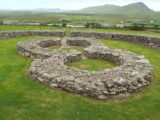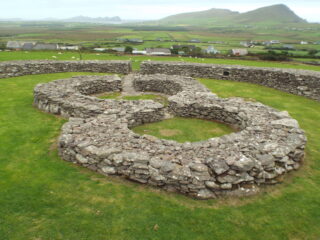Fógra
WARNING: It should be noted that these sites are unguided and a level of care and caution should be maintained during all stages of your visit. The Office Of Public Works (OPW) will not be held responsible for any damages, injuries, or losses that occur
Ballynavenooragh
Cathair Fionnúrach (The fortress of Fionnúrach) is one of a series of cashels (ringforts built of stone), and isolated clocháns (corbelled stone beehive style huts), at the foot of Mount Brandon, approximately 10 kilometres north of Dingle town. There is a cluster of forty cashels, two dozen clocháns and two cilliní (ancient graveyards possibly marking the sites of ancient churches) in the area. Four of these archaeological sites have been designated as National Monuments.
The first of these is Cathair Fionnúrach: a series of four national monuments in close proximity, giving its name to the local townland Baile na bhFionnúrach (the town of Fionnúrach), which has been anglicised to Ballynavenooragh. This is one of 60,000 ringforts built across Ireland between 550 – 900AD as defensive homesteads for wealthy farmers. The site was excavated by archaeologist Erin Gibbons in the 1990s and she found that it was constructed in the 7th century and was continually occupied until the 10th century. The cashel was re-occupied in the 13th century. The cashel is quite large with the internal diameter measuring 27metres and its stone walls survive to a height of 1.7metres. Gibbons’ excavations discovered apple, blackberry and grape seeds; the latter suggesting that the fort’s inhabitants were quite wealthy and had access to foreign sea trade. The remains of hazelnuts were also found. Amongst the artefacts recovered were stone tools, pottery, iron knives, a blue glass bead, and crucible fragments which suggest that there was metalwork and industry taking place on site. Two 13th century coins (silver pennies of Henry III) were also unearthed. The postholes in the site showed that willow and alder were used to construct internal features, likely because of a lack of oak trees in the immediate area. A slight trench 20cm deep, running inside the cashel wall is probably part of a recent attempt to drain the interior. There are a pair of two co-joined huts inside the fort, the larger one having a diameter of 6.5 metres, the smaller being 4.5metres wide. A recess at the base of the north-eastern wall of the smaller hut formerly provided access to a souterrain which is now blocked. This underground passage constructed in the early medieval period for use as a cellar for food storage but which may also have doubled as a hidden refuge in times of crisis. This tunnel was built of drystone construction with a stone-flag room. The passage from the entrance is 2.7metres long and descends down three stone steps into a large chamber 6 metres long, 1.5metres wide and 3 metres high. To the east of the fort and immediately south of its entrance are three clocháns which may have been in contemporary use at the same time as the fort.
The second National Monument is a double clochán approximately 300 metres east-north-east of Cathair Fionnúrach consisting of two circular conjoined huts of drystone corbelled construction, with a souterrain opening off the base of the eastern wall of the northern hut. The southern part of the structure has three internal wall niches.
The third National Monument is another clochán or hut site in a good state of preservation approximately 300 metres north-east of Cathair Fionnúrach.
The fourth and final National Monument in the area is another clochán or hut in close proximity to the others.
Visit Historic Environment Viewer for more information on Ballynavenooragh
Protect our Past - Click here to read about the importance of protecting our country’s unique heritage sites
This national monument is protected in accordance with the National Monuments Acts 1930 to 2014
Gailearaí
Suíomhanna cóngarach
Ionad an Bhlascaoid
An scéal a bhaineann le pobal uathúil oileánda
Timpeall 15.7 km ón
Ardeaglais Ard Fhearta
Trí shéipéal mheánaoiseacha tiomanta do Naomh Breandán
Timpeall 36.3 km ón
Maoin Oidhreachta Domhanda EOECNA Sceilg Mhichíl
Mainistir Oileánda ina seasamh go hard os cionn na farraige
Timpeall 52.4 km ón


